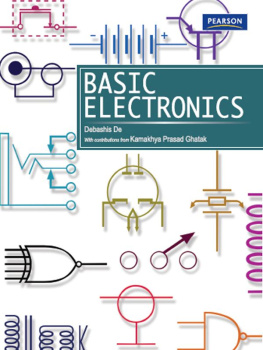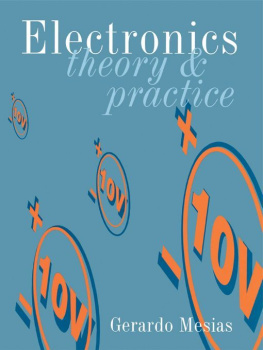Sean Westcott - Basic Electronics: Theory and Practice
Here you can read online Sean Westcott - Basic Electronics: Theory and Practice full text of the book (entire story) in english for free. Download pdf and epub, get meaning, cover and reviews about this ebook. year: 2020, publisher: Mercury Learning and Information, genre: Science / Computer. Description of the work, (preface) as well as reviews are available. Best literature library LitArk.com created for fans of good reading and offers a wide selection of genres:
Romance novel
Science fiction
Adventure
Detective
Science
History
Home and family
Prose
Art
Politics
Computer
Non-fiction
Religion
Business
Children
Humor
Choose a favorite category and find really read worthwhile books. Enjoy immersion in the world of imagination, feel the emotions of the characters or learn something new for yourself, make an fascinating discovery.
- Book:Basic Electronics: Theory and Practice
- Author:
- Publisher:Mercury Learning and Information
- Genre:
- Year:2020
- Rating:4 / 5
- Favourites:Add to favourites
- Your mark:
- 80
- 1
- 2
- 3
- 4
- 5
Basic Electronics: Theory and Practice: summary, description and annotation
We offer to read an annotation, description, summary or preface (depends on what the author of the book "Basic Electronics: Theory and Practice" wrote himself). If you haven't found the necessary information about the book — write in the comments, we will try to find it.
Basic Electronics: Theory and Practice — read online for free the complete book (whole text) full work
Below is the text of the book, divided by pages. System saving the place of the last page read, allows you to conveniently read the book "Basic Electronics: Theory and Practice" online for free, without having to search again every time where you left off. Put a bookmark, and you can go to the page where you finished reading at any time.
Font size:
Interval:
Bookmark:
BASIC
ELECTRONICS
Third Edition
LICENSE, DISCLAIMER OF LIABILITY, AND LIMITED WARRANTY
By purchasing or using this book and disc (the Work), you agree that this license grants permission to use the contents contained herein, but does not give you the right of ownership to any of the textual content in the book or ownership to any of the information or products contained in it. This license does not permit uploading of the Work onto the Internet or on a network (of any kind) without the written consent of the Publisher. Duplication or dissemination of any text, code, simulations, images, etc. contained herein is limited to and subject to licensing terms for the respective products, and permission must be obtained from the Publisher or the owner of the content, etc., in order to reproduce or network any portion of the textual material (in any media) that is contained in the Work.
MERCURY LEARNING AND INFORMATION (MLI or the Publisher) and anyone involved in the creation , writing, or production of the companion disc, accompanying algorithms, code, or computer programs (the software), and any accompanying Web site or software of the Work, cannot and do not warrant the performance or results that might be obtained by using the contents of the Work. The author, developers, and the Publisher have used their best efforts to insure the accuracy and functionality of the textual material and/or programs contained in this package; we, however, make no warranty of any kind, express or implied, regarding the performance of these contents or programs. The Work is sold as is without warranty (except for defective materials used in manufacturing the book or due to faulty workmanship).
The author, developers, and the publisher of any accompanying content, and anyone involved in the composition, production, and manufacturing of this work will not be liable for damages of any kind arising out of the use of (or the inability to use) the algorithms, source code, computer programs, or textual material contained in this publication. This includes, but is not limited to, loss of revenue or profit, or other incidental, physical, or consequential damages arising out of the use of this Work.
The sole remedy in the event of a claim of any kind is expressly limited to replacement of the book and disc, and only at the discretion of the Publisher. The use of implied warranty and certain exclusions vary from state to state, and might not apply to the purchaser of this product.
Companion files may also be obtained by writing to the publisher at .
BASIC
ELECTRONICS
Theory and Practice
Third Edition
SEAN WESTCOTT
JEAN RIESCHER WESTCOTT

MERCURY LEARNING AND INFORMATION
Dulles, Virginia
Boston, Massachusetts
New Delhi
Copyright 2020 by MERCURY LEARNING AND INFORMATION LLC. All rights reserved.
This publication, portions of it, or any accompanying software may not be reproduced in any way, stored in a retrieval system of any type, or transmitted by any means, media, electronic display or mechanical display, including, but not limited to, photocopy, recording, Internet postings, or scanning, without prior permission in writing from the publisher.
Publisher: David Pallai
MERCURY LEARNING AND INFORMATION
22841 Quicksilver Drive
Dulles, VA 20166
www.merclearning.com
(800) 232-0223
S. Westcott and J. R. Westcott. Basic Electronics: Theory and Practice. Third Edition.
ISBN: 978-1-68392-528-6
The publisher recognizes and respects all marks used by companies, manufacturers, and developers as a means to distinguish their products. All brand names and product names mentioned in this book are trademarks or service marks of their respective companies. Any omission or misuse (of any kind) of service marks or trademarks, etc. is not an attempt to infringe on the property of others.
Library of Congress Control Number: 2020937122
202122 3 2 1 This book is printed on acid-free paper in the United States of America.
Our titles are available for adoption, license, or bulk purchase by institutions, corporations, etc. For additional information, please contact the Customer Service Dept. at (800)232-0223(toll free).
All of our titles are available in digital format at . The sole obligation of MERCURY LEARNING AND INFORMATION to the purchaser is to replace the disc, based on defective materials or faulty workmanship, but not based on the operation or functionality of the product.
CONTENTS
INTRODUCTION
T he study of electronics can be a little overwhelming when you start out. But without assuming that you remember everything from your general science classes, we take you through it all step by step so that you will gain confidence in your understanding of the material. This doesnt mean that we give you an oversimplified version of electronics, but it does mean that we cover the topics in a more digestible style. We believe that by making the effort to wrap your head around some of the more difficult topics, you will find it easier to progress into further study of electronic theory or hands-on experimentation.
We believe that a new revolution is under way. Electronics has always had a thriving hobbyist population, especially in the 1960s and the 1970s. There were magazines, corner electronics stores; and clubs where enthusiasts could meet and share their creations. It had its subcultures from amateur radio enthusiasts to model rocket builders. In the 1980s, this culture grew to include people building personal computers before such companies such as IBM and Apple began to mass produce them.
The hobbyist field changed as electronics advanced. The increasing sophistication and miniaturization of electronic components and the products built with them made hobbyist-built electronics pale in comparison to their flashier, mass-produced competition. But those same advances are now putting the design and production back into the hobbyists hands. Perhaps egged on by battling robots out of university engineering departments, a new generation of electronics buffs is tinkering with technology. With affordable microcontrollers and a wide range of products and information available online, the hobbyist can design and build machines that recharge the ideas of homebrew and do-it-yourself. We can all become Makers.
HOW THIS BOOK IS ORGANIZED
Part 1: The Fundamentals covers electronics basics from the atoms up. You learn about currents, AC and DC voltage, and find out how they all work together to power our world.
Part 2: Your Workspace and Tools introduces the tools of the trade, from the low-tech soldering iron that makes your connections to the high-tech digital multimeter, and offers advice for setting up a shop and working with electricity safely.
Part 3: Electronic Components gives you the nitty-gritty on circuits, capacitors, diodes, transistors, and power supplies. These components are the workhorses of electronics, keeping things powered, amped up, and running smoothly.
Next pageFont size:
Interval:
Bookmark:
Similar books «Basic Electronics: Theory and Practice»
Look at similar books to Basic Electronics: Theory and Practice. We have selected literature similar in name and meaning in the hope of providing readers with more options to find new, interesting, not yet read works.
Discussion, reviews of the book Basic Electronics: Theory and Practice and just readers' own opinions. Leave your comments, write what you think about the work, its meaning or the main characters. Specify what exactly you liked and what you didn't like, and why you think so.









